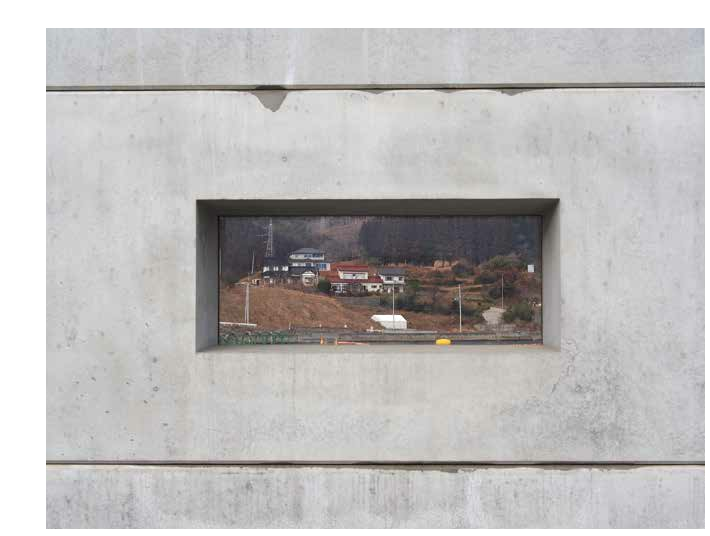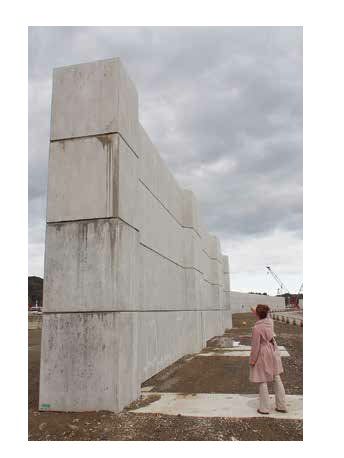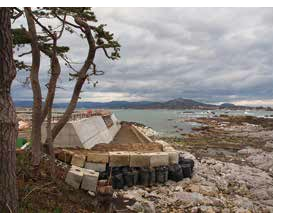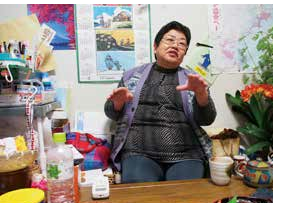Issue:

While some believe seawalls are part of reconstruction, others fear they could lead to a false sense of security, destroy nature and tear communities apart.
Keiko Sugawara is smiling as she talks about seawalls. Standing in Kesennuma harbor in front of the recently constructed wall of concrete that soars four times her height, she seems unaware of the ice-cold winds strong enough to pierce the skin on this cold February Sunday. Her pleasant expression, however, is disconcerting; her speech is agitated, and there is something else behind her smile: sadness, frustration, maybe even despair. She is afraid that the walls might ruin the future of the children of Kesennuma by destroying what she sees as the city’s biggest asset its natural resources and beautiful natural surroundings. “I really don’t like adults pushing decisions onto children,” says the stylish, young-looking 49-year old. “It hurts my heart.”
Driving along the east coast of Tohoku, where a magnitude 9.0 quake unleashed a towering tsunami which devastated over 400 kilometers of coastline on March 11, 2011, it is easy to get lost. It has become hard to judge when to rely on car navigation and when to ignore it. In Otsuchi, for example, the system shows our car traveling on a railway track, when we’re actually on a dirt road. In Minamisanriku, the empty frame of the disaster prevention center, which used to be a sort of landmark, can now easily be missed in its location among several huge pyramid-like embankments of bare earth, meant to eventually host industrial and public facilities.
What will even further change the landscape is the decision of many communities to build large seawalls. Proponents say these will keep citizens safe and allow reconstruction to speed up. “We only get money from the government for reconstruction if we build this wall,” was a statement heard coming from many local politicians’ election campaigns.
But Sugawara and other opponents fear that these concrete bulwarks might destroy what little is left of the assets of the area, like the picturesque rugged ria coast. They worry about potential negative effects on tourism and the fishing industry, which could hamper job prospects for young people in particular. Another fear is that people could develop a false sense of security behind the walls and delay their escape after a strong earthquake especially since the walls will block any view of the sea. This could lead to an even higher death toll next time a tsunami hits.
SUGAWARA EMPHASIZES THAT SHE is not against seawalls per se. “Walls of a certain size are necessary to protect harbor areas from high tide and high waves in stormy weather,” she says. “But I am against such gigantic concrete walls.” On average, they will measure about 10 meters high.
Initially on the side of the walls’ supporters, she had a change of heart after realizing that the walls would not be effective against a tsunami of the same scale as five years ago an event said to occur only once in several hundred years. They would only hold back the smaller, though more frequent, ones. Also, little to no maintenance of the walls was planned, meaning they would only be taken care of after the next disaster.
But vocal opponents like Sugawara seem to be few and far between, and some fear the seawall issue might even tear the communities apart. There is always the risk of being ostracized by the tightly knit local communities and labeled as someone holding up reconstruction. “When I talk with people in private, many agree,” Sugawara says, “but they are afraid to speak up in public.”
Sugawara did find backing from Setsuko Komatsu, a former local assemblywoman. Komatsu’s house, close to the riverbank, was swept away by the tsunami. Now the 68 year old shares two units in temporary housing with her extended family in Oya, half an hour south of Kesennuma. Sugawara sometimes visits Komatsu, exchanging ideas over coffee in a crammed 4.5-square-meter living space. Now Komatsu and her 70-year-old husband are planning to move to an elevated spot. “People moved to higher ground after previous inundations, too,” she says. In her opinion, one of the biggest obstacles in their fight against the walls is that people cannot really imagine what these tall walls will look like. Sugawara suggests building a model to help understand the concept.
Much to their surprise, the two women received support from an unexpected source: Shigemitsu Sato is in charge of CSR activities at Sugawara Industry, a company of 30 employees that is building the seawall in Kesennuma. “There are only few jobs here, and I need to live off something,” the 40-year-old father of two explains. “I had hoped I could influence the pro-cess from the inside.” Dressed in jeans and a stained blue-down jacket, he joined Sugawara for an impromptu meeting at the seawall section close to the pre-fectural government office in Kesennuma.
“The walls will destroy the value of our town,” he says. “It is my mission to destroy them.” Later he clarified his statement, saying he wants to build more innova-tive ones. Sato’s criticism is that the walls were mostly designed at the corporate level, without con-sidering the surroundings. More research should have been done, he says and he also expresses doubt about the calculations behind the strength of the walls. He points to the small window slits in the walls. “The only rea-son they were added was so the report would be accepted by the Ministry of Land, Infrastructure, Transport and Tourism,” he says. “Isn’t that ridiculous?” Both he and Sugawara criticize the wall’s shape: Once water spills over, the structure will block it from flowing back out to sea, thereby creating a huge lagoon.
In neighboring Minamisanriku, Yutaka Tabata, a pensioner in his seventies, is aware of the debate going on in Kesennuma. He is sitting with several elderly women at a table in a new recreation room next to a newly built apartment block, making dolls from pieces of cloth and Q-tips. “The walls are built for safety and to feel safe,” says Toshiko Sato, one of the women. While Tabata agrees with her, he also wants broad escape routes built and disaster drills held. Like activist Sugawara, he fears that the walls could lead to people delaying escape.
“THERE ARE NO SIMPLE truths when it comes to the seawall issue,” says Dr. Christian Dimmer, a German urban studies scholar architect and assistant professor of urban design at Tokyo University. He says that what Japan lacks most is a cul-ture of openly discussing pros and cons of a project, without a predetermined outcome. Sugawara confirms that this is what happened, that explanatory meetings were only held to report a decision already made.



Another brick in the wall
Keiko Sugawara stands before the seawall under construction in Kesennuma; the changing coastline; former local assemblywoman Setsuko Komatsu at home in her temporary housing.
“Good leadership and a strong sense of community are key,” says Dimmer, before mentioning the town of Onagawa. Despite losing 570 of its then 10,000 citizens and 80 percent of the town’s buildings, Onagawa quickly decided against building a seawall. Some say that is why reconstruction in the town has progressed so rapidly and so well. “We live from the sea and with it,” is what one often hears from locals in Onagawa.
Despite the setbacks, clearly represented by the towering walls at her back, Sugawara does not want to give up her campaign against the walls. “I will do what I can, tirelessly,” she said, “to combat the false information that is being spread.” She is afraid that once the walls in Tohoku are finished, it will set a precedent for the rest of the country, and even more walls will be built. She hopes people can be inspired to reconsider the value of their hometowns.
While she remains passionate in her beliefs, Sugawara has not been immune to social pressure. Once, during an information session, she was asked to leave by the organizer, who was aware of her position on the issue. She also fears that her activities might hurt her family’s business, a small electronic appliances store. She tries to fly under the radar, but is still in the fight, belonging to two local opposition groups and frequently posting on Facebook. “I have not told my family about what I’m doing,” she said with a somewhat sad smile, “but maybe they already know.”
Sonja Blaschke is a German freelance journalist writing for publications in Germany, Austria and Switzerland. She also works as a TV producer.

